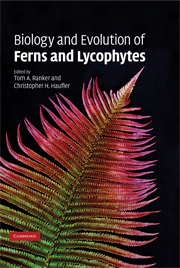Book contents
- Frontmatter
- Contents
- List of contributors
- Preface
- Acknowledgments
- Part I Development and morphogenesis
- Part II Genetics and reproduction
- Part III Ecology
- 8 Phenology and habitat specificity of tropical ferns
- 9 Gametophyte ecology
- 10 Conservation biology
- 11 Ex situ conservation of ferns and lycophytes – approaches and techniques
- Part IV Systematics and evolutionary biology
- Index
- References
11 - Ex situ conservation of ferns and lycophytes – approaches and techniques
Published online by Cambridge University Press: 11 August 2009
- Frontmatter
- Contents
- List of contributors
- Preface
- Acknowledgments
- Part I Development and morphogenesis
- Part II Genetics and reproduction
- Part III Ecology
- 8 Phenology and habitat specificity of tropical ferns
- 9 Gametophyte ecology
- 10 Conservation biology
- 11 Ex situ conservation of ferns and lycophytes – approaches and techniques
- Part IV Systematics and evolutionary biology
- Index
- References
Summary
Introduction
Although generally less conspicuous than seed plants, ferns and lycophytes have been the object of human interest since at least the time of the ancient Greeks. As with other plant and animal species, habitat loss is the major threat, but harvesting for medicine, food, or as ornamental plants has also depleted some species in the wild. Of the approximately 13000 named species, approximately 800 are of conservation concern (Walter and Gillett, 1998). However, some areas of the world are still poorly explored for ferns and lycophytes, and although the exact number of endangered species is uncertain, many species are in habitats that are under pressure. While conserving species in situ is the ideal, it cannot always be ensured. As a result, ex situ conservation methods can play a complementary role in ensuring the survival of these species, by providing a back-up of genetic diversity for the populations in the wild.
Growing ferns and lycophytes ex situ as horticultural or botanically interesting specimens has a long history, but other ex situ conservation methods, such as spore banking and cryopreservation are more recent. Whereas spore banking follows protocols similar to those of seed banking, the independent alternation of generations in ferns and lycophytes provides opportunities for cryopreservation that are not available in seed plants. Previous reviews have described some of these possibilities (Page et al., 1992; Pattison et al., 1992; Pence, 2002).
- Type
- Chapter
- Information
- Biology and Evolution of Ferns and Lycophytes , pp. 284 - 300Publisher: Cambridge University PressPrint publication year: 2008
References
- 8
- Cited by



